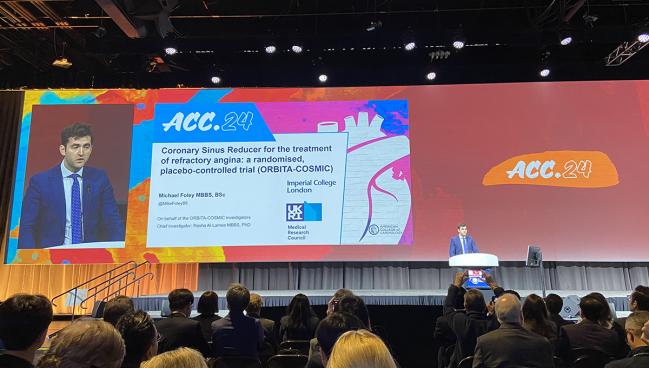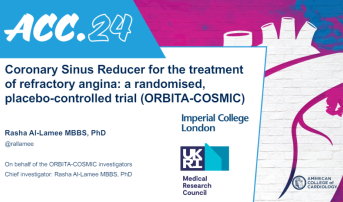Coronary Sinus Reducer Eases Symptoms in Refractory Angina: ORBITA-COSMIC
In this placebo-controlled study, CMR imaging disappointed a little, but the device did make patients feel better.

ATLANTA, GA—An implantable coronary sinus reducer (CSR) in patients with refractory angina significantly reduces symptoms over 6 months of follow-up compared with a placebo procedure, a new study shows.
Despite the reduction in the number of daily angina episodes, investigators were unable to fully uncover the mechanism of action with the CSR, with imaging data showing there was no improvement in myocardial blood flow to ischemic segments.
Senior investigator Rasha Al-Lamee, MBBS, PhD (Imperial College London), called the mechanism of action “unintuitive.”
“We don't really understand how this would work on angina,” she told TCTMD. “It had been postulated that it works by improving myocardial perfusion or by redistributing myocardial blood flow. Only on one secondary endpoint did we find something that might make us think about the mechanism of action, which is a redistribution of myocardial perfusion from the epicardium to the sub-endocardium. Of course, we need to look at that further.”
We don't really understand how this would work on angina. Rasha Al-Lamee
Tommaso Gori, MD (University Medical Center, Mainz, Germany), who wasn’t involved in the study, said that while ORBITA-COSMIC failed to show the device had an effect on its primary “mechanistic” outcome, the primary symptom endpoint “was clearly positive.”
“The device appears to work,” he told TCTMD. “We don’t completely understand how it works, but even with the MRI data, they do show what previous animal data has shown: that there is a transfer of blood from the epicardium to the endocardium and this appears to be part of the mechanism of how the reducer works.”
Regardless of mechanisms, Stefan Verheye, MD, PhD (Antwerp Cardiovascular Center, Belgium), who led the sham-controlled COSIRA-1 trial, a small study of CSR with 104 patients, said there is a large need for another treatment for patients with refractory angina.
“These patients have several angina episodes,” he told TCTMD. “When a physician tells you, ‘Look, there's no other option. We can't do PCI, we can't do CABG, but your coronary arteries are sick and there’s not much we can do about it,’ that really scares them. They have symptoms every day and they’re already taking several tablets.”
Moreover, said Verheye, they only have a modest mortality risk and their current quality of life is extremely poor. “They are scared to exercise because when they do they get angina,” he said. “There’s an unbelievable need to help these patients.” For that reason, Verheye said the clinical findings in ORBITA-COSMIC are what really matters.
“When you think about it, there’s only 50 patients and to demonstrate that there is a clinical improvement, that’s big,” he said.
Sole Aim of CSR Is Symptom Relief
In Europe, the implantable CSR (Neovasc Reducer; Shockwave Medical) has had CE Mark approval since 2011 and currently carries a class IIb guideline recommendation for use.
In the US, it’s been designated a breakthrough device by the US Food and Drug Administration but is not yet approved for commercial use. In 2020, an FDA advisory committee voted against approving the Neovasc CSR device for patients with refractory angina, stating that more data were needed. Since then, the manufacturer has launched COSIRA-II, the investigational device exemption (IDE) sham-controlled trial expected to enroll 380 patients with refractory angina.
The hourglass-shaped, stainless-steel mesh CSR is percutaneously implanted in the coronary sinus and reduces angina symptoms by altering blood flow through the heart. As noted, it acts on venous circulation and is thought to work by shifting oxygenated blood to ischemic areas of the heart. Foley said the “sole aim” of the CSR is angina relief, noting the concept of narrowing the coronary sinus to help ischemic myocardium began in the mid-20th century with surgical ligation techniques.
When you think about it, there’s only 50 patients and to demonstrate that there is a clinical improvement, that’s big. Stefan Verheye
The placebo-controlled ORBITA-COSMIC study was led by the same group who conducted the ORBITA and ORBITA-2 trials testing PCI for the treatment of stable angina, with patients blinded as to whether they’d received a real or mock procedure. This new study was done at six hospitals in the UK, and patients were eligible for enrollment if they had angina, epicardial coronary artery disease, ischemia, and no further options for antianginal therapy, such as further medication use, PCI, or CABG surgery.
All patients underwent adenosine-stress cardiac magnetic resonance with perfusion mapping and were instructed on the use of a smartphone application to record the number of daily angina episodes throughout the study. Patients also completed symptom and quality-of-life questionnaires. Angina severity was graded by investigators based on a treadmill exercise test. Eligible patients then entered a 2-week prerandomization symptom-assessment phase where they reported symptoms using the smartphone app.
If patients had appropriate right atrial pressure, measured by invasive cardiac catheterization, and coronary sinus anatomy, verified by venogram, they were sedated and randomized to receive either placebo procedure or CSR. In total, 51 patients were randomized, with 24 in the CSR arm (median age 72 years; 84% male) and 26 in the placebo group (median age 67 years; 88% female), available for the intention-to-treat analysis. Most of the patients (94%) has CCS class III or IV angina prior to randomization and were taking three antianginal medications at enrollment.
For the primary study outcome, there was no benefit of CSR over the placebo in stress myocardial blood flow in the segments deemed ischemic. However, the ratio of endocardial to epicardial blood flow improved in the CSR group, with evidence of an effect between the ischemic and nonischemic segments.
Regarding symptoms, patients were more likely to have a lower number of daily episodes of angina as recorded on the ORBITA app (OR 1.40; 95% CI 1.08-1.03). Over 6 months, a patient with angina would be expected to have 84.5 days free from angina with a CSR compared with 71.5 days if treated with placebo. Both the Seattle Angina Questionnaire (SAQ) angina frequency and MacNew heart disease health-related quality of life scores improved with CSR over placebo.
There was no difference in treadmill exercise time between study arms.
Very Debilitated Patient Population
Speaking during the discussion, Timothy Henry, MD (The Christ Hospital, Cincinnati, OH), who is leading COSIRA-II along with Gregg Stone, MD (Icahn School of Medicine at Mount Sinai, New York), noted that the primary endpoint of their IDE trial is change in total exercise duration. However, he said their research team will take a close look at ORBITA-COSMIC to determine if perhaps a symptom-based endpoint might have been better.
In response, Foley said they considered exercise time as the primary endpoint but felt a daily angina assessment provided greater sensitivity to symptomatic changes, as well as information about the time course of improvement.
Al-Lamee pointed out that patients in ORBITA-COSMIC were extremely debilitated, with many of them reporting six angina episodes per day. Designing a trial around exercise time in such patients would have been very difficult. In fact, COSIRA-II has entry criteria for exercise treadmill times, said Al-Lamee, which many of the patients in their trial would not have met. “Importantly, this is a population of patients who very rarely return to freedom from angina,” she said. “What we see is that you can reduce angina episodes, but I worry about a treadmill-exercise-time endpoint in this population.”
I have a conflict of interest, of course—I do implant the device—and see many patients who profit from it. Tommaso Gori
To TCTMD, Gori said that there is “a bit of a disconnect” between symptoms and exercise capacity. “I always say to patients that we don’t fully understand ischemia,” he said. “The relationship between symptoms or reports of symptoms and exercise capacity in all studies is very weak.”
In another ACC session, Verheye presented data on approximately 400 patients treated with CSR in the REDUCER-1 postmarketing study. In that analysis, nearly 70% of patients had a one-class improvement in CCS angina score after treatment and 24.1% had a two-class improvement. Six months after treatment, 18.2% of patients has class III/IV angina symptoms compared with 72.2% at baseline. There were also significant improvements in the Seattle Angina Questionnaire and 6-minute walk test, he said, and these changes in CCS and quality-of-life were durable out to 3 years. Importantly, there was no signal of harm.
“It’s a safe technique,” added Verheye. “If you implant it, and they have no improvement, they don’t get worse.”
For Gori, CSR is an effective treatment for patients with no other options.
“I have a conflict of interest, of course—I do implant the device—and see many patients who profit from it,” he said. “This is my experience, and honestly I see patients in the same relationship as the studies show—about two-thirds benefit and then there are nonresponders, but this is a thing for every single intervention.”
Al-Lamee said that in some patients with very advanced coronary artery disease, treatment will sometimes depend on the skill sets of treating physicians, such as their ability to perform chronic total occlusion or complex PCI. However, these are high-risk procedures not suitable options for all patients. In such instances, physicians might consider a CSR device in the venous circulation, something that would allow them options for future interventions, but which would reduce angina in the interim and improve quality of life.
Michael O’Riordan is the Managing Editor for TCTMD. He completed his undergraduate degrees at Queen’s University in Kingston, ON, and…
Read Full BioSources
Foley MJ, Rajkumar CA, Ahmed-Jushuf F, et al. Coronary sinus reducer for the treatment of refractory angina (ORBITA-COSMIC): a randomized, placebo-controlled trial. Lancet. 2024;Epub ahead of print.
Disclosures
- Foley reports speaker’s fees from Menarini and Philips.
- Al-Lamee reports serving on a trial steering committee for Janssen Pharmaceuticals and on an advisory board for Abbott and Philips. She reports speaker’s honoraria from Abbott, Philips, Medtronic, Servier, Omniprex, and Menarini.
- Gori reports prior grant support from Neovasc Inc, the developer of the CSR.
- Verheye reports consulting fees from Neovasc/Shockwave, Elixir Medical, and V-Wave.







Comments